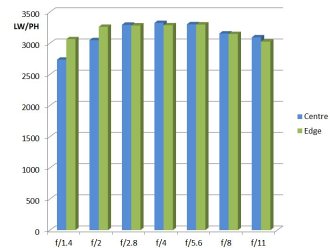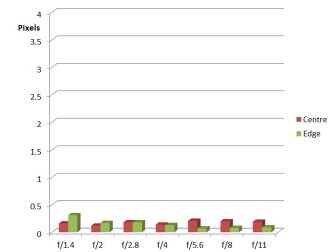Zeiss Milvus 85mm f/1.4 Review
Zeiss Milvus 85mm f/1.4 Performance
85mm lenses, often used for portraits, have in the past been designed with fairly weak open aperture performance, crisping up when stopped down perhaps 2 or 3 stops. More recently, the tendency has been to make the lenses razor sharp right from wide open, perhaps using soft focus filters if needed to make the results a little kinder to the subject, the classic being the Zeiss “Softar” range.
Zeiss have definitely opted for the razor sharp approach with the Milvus, and the lens is simply excellent, centre and edge, all the way through the aperture range. There may be variation in the bald figures, but they all fall comfortably into the “excellent” category and visually it makes no difference to sharpness whatever aperture is chosen. The aperture effectively just controls the depth of field.
How to read our charts
The blue column represents readings from the centre of the picture frame at the various apertures and the green is from the edges.The scale on the left side is an indication of actual image resolution as LW/PH and is described in detail above. The taller the column, the better the lens performance.
For this review, the lens was tested on a Nikon D600 using Imatest.
Chromatic aberration (CA) results from a lens not focusing the different colours of light at the same point. In the case of the Milvus 85mm, CA is impressively close to zero at all apertures. Flare is also entirely absent, a combination of the effects of good design, multi-coating and an effective lens hood.
How to read our charts
Chromatic aberration is the lens' inability to focus on the sensor or film all colours of visible light at the same point. Severe chromatic aberration gives a noticeable fringing or a halo effect around sharp edges within the picture. It can be cured in software.Apochromatic lenses have special lens elements (aspheric, extra-low dispersion etc) to minimize the problem, hence they usually cost more.
For this review, the lens was tested on a Nikon D600 using Imatest.
Distortion is also very low, actually measuring at just -0.0471% barrel. With such a low distortion figure straight lines should remain as straight lines. This will be a useful feature with architectural photography in particular.
Bokeh, the rendition of the out of focus areas in an image, is a major consideration for many photographers. The Milvus 85mm renders such areas very well, with smooth rendition of even quite busy detail. Although there are other lenses just as good in this respect, the Milvus acquits itself very well indeed.
In summary, the lens is a pleasure to use, with beautiful rendition of a variety of subject matter. Results are impressive.
Value For Money
There is a wide choice of 85mm lenses available, perhaps unsurprisingly as this is the classic focal length for portraits. The Zeiss Milvus 85mm f/1.4 costs £1379, at the high end of the options, but equalled in cost by the Canon EF 85mm f/1.2 L II USM (£1499) and the Nikon 85mm f/2.8 D PC-E Micro-Nikkor (£1299). The Nikon is also a perspective control lens, adding yet another dimension of possibilities. Zeiss also offer the 85mm f/1.4 Planar (£989) and the Otus 85mm f/1.4 (£3299). The Zeiss lenses are all manual focus only.
Alternative lenses from Nikon are the 85mm f/1.8 G AF-S (£399) and the 85mm f/1.4 G AF-S (£1199). Canon also has the EF 85mm f/1.8 at £237, or the EF 85mm f/1.2 L II USM (£1499), as previously mentioned.
Sigma offer the 85mm f/1.4 EX DG HSM (£619). Manual focus options come from Samyang and Lomo. The Samyang 85mm f/1.4 IF MC costs £249 and the Lomo 85mm f/2.2 Petzval Art Lens Brass is £459, or the black version is £549. There is also the new Tamron SP 85mm f/1.8 Di VC USD at £749.
Add your message
Please login here or if you've not registered, you can register here. Registering is safe, quick and free.
photodo Stats
428 MTF tests
74 in-depth photodo reviews
100+ users join each day
Help the lens community by reviewing or rating a lens today via our lens search
Latest Lens Reviews
- Chinon 28mm f/2.8 Vintage Lens Review
- Canon EF 70-200mm f/4L IS II USM Lens Review
- Samyang AF 85mm f/1.4 EF Review
- Sigma 70mm f/2.8 DG Macro Art Review
- Samyang AF 24mm f/2.8 FE Review
- Meike 50mm f/1.7 Review
- Tamron 70-210mm f/4 Di VC USD Review
- Lensbaby Burnside 35mm f/2.8 Review
- Asahi Super Takumar 50mm f/1.4 Review
- Asahi Super-Multi-Coated Takumar 135mm f/3.5 Review


